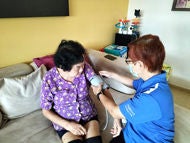What is - Endometriosis
What is endometriosis?
Endometriosis is a chronic condition affecting about 10% of women where the endometrial tissue (tissue that normally lines the cavity of the uterus) grows outside the cavity of the uterus. This abnormal growth can occur on the ovaries, causing the formation of cysts, otherwise known as endometriomas. They can also occur on other organs in the pelvis such as the fallopian tubes, intestines, urinary tract and the lining of the pelvis. Less commonly, they can occur outside the pelvis, onto structures such as the diaphragm. Just like how the lining inside the uterus would respond to the hormones in our menstrual cycle, these tissue growths can thicken and breakdown with each menstrual cycle, causing inflammation and damage to the surrounding healthy tissue. Scar tissue as a result of the inflammation can result in bands called adhesions which cause pelvic tissues and organs to stick together.
As a result, endometriosis can cause pain, especially during the menstrual period. Because of the loss of normal anatomy from adhesions and inflammation in the pelvis, some women may also experience fertility problems.
What are the types of endometriosis?
Endometriosis can be classified into several types based on its location and severity. The main types are:
- Superficial peritoneal endometriosis
- The most common type.
- Occurs on the peritoneum (the thin layer lining the pelvis and abdomen) and involves surface-level lesions.
- Ovarian endometriomas (endometriotic cysts)
- Also called "chocolate cysts.
- Occurs when endometrial tissue forms cysts in or on the ovaries. These cysts contain thick dark blood.
- Deep infiltrating endometriosis:
- A more severe form where endometrial tissue invades organs deep within the pelvis, such as the bladder, bowels or uterosacral ligaments (ligaments that support your uterus and holds it in place).
- This type can cause more significant pain and complications.
- Adenomyosis:
- Sometimes considered a type of endometriosis.
- Involves endometrial tissue growing into the muscle wall of the uterus, leading to painful heavy periods.
Rarer forms of endometriosis
Cyclical pain during menses in an old operation scar (e.g. caesarean section scar) may suggest that there is endometriosis in it. Coughing up blood during your menses may indicate lung endometriosis.
Symptoms of Endometriosis
What are the symptoms of endometriosis?
The main symptom of endometriosis would be painful menstrual periods, also known as dysmenorrhoea. This pain may sometimes start before the onset of menses. Although some women may have cramping pains during their menstrual period, those with endometriosis describe their pain as a lot worse than usual and often not helped with over the counter painkillers. Other common symptoms include:
- Pain during intercourse
- Pain with bowel movements or urination during menstrual period
- Excessive bleeding during menstrual period
- Infertility
- Non-specific symptoms like bloating, fatigue, lower back pain, nausea, constipation and diarrhoea.
In rare cases where the endometriosis has involved the rectum or bladder, you may have bleeding from the back passage or bleeding when you pass urine during menses.
It is however important to note that the severity of your pain may not correspond to how much disease there is in the pelvis. Some women with lots of endometriotic tissue growths may experience little or no pain while some with small amounts of endometriotic tissue have very severe pain. For those with little or no pain, this condition can be discovered incidentally when scans are ordered for other reasons or when they have problems getting pregnant.
When should you see a doctor?
You should seek medical advice if you have painful menstrual periods that is affecting your quality of life, work and relationships or if you think you might have symptoms of endometriosis.
By seeking help early, you can take control of your symptoms and get the necessary treatments.
Endometriosis - Causes and Risk Factors
What causes endometriosis?
The cause of endometriosis is still unknown. However, some possible theories include:
- Retrograde menstruation: Rather than leaving the body, menstrual blood travels backward through the fallopian tubes, and then into the pelvic cavity. This blood contains endometrial cells, which can attach to the pelvic organs and walls, leading to tissue growth and bleeding during each menstrual cycle.
- Immune system Issues: An impaired immune system might fail to detect and remove endometrial tissue that is growing outside the uterus.
- Peritoneal cell transformation: Some experts think that peritoneal cells (cell which line the inner side of the pelvis or abdomen) may be transformed by hormonal or immune factors into cells resembling endometrial tissue
- Embryonic cell changes: Hormones such as oestrogen may cause the transformation of embryonic cells (cells in their earliest stages of development) into cells resembling endometrial tissue during puberty
- Endometrial cell transport: Blood vessels or tissue fluid systems may transport endometrial cells to other parts of the body
What are the risk factors for endometriosis?
Several factors contribute to an increased risk of developing endometriosis, including:
- Family history: A key risk factor for endometriosis.
- Early menstruation: Starting periods at a younger age.
- Later menopause: Going through menopause at a later age
- Short menstrual Cycles: Having cycles shorter than 27 days.
- Heavy periods: Experiencing excessive menstrual bleeding.
- Delayed childbearing: Women who have not had children face a higher risk.
Diagnosis of Endometriosis
How is endometriosis diagnosed?
As endometriosis symptoms can be similar to other conditions such as irritable bowel syndrome, pelvic inflammatory disease, fibroids and adenomyosis, diagnosis may require a combination of examinations and imaging. A detailed history will be taken by your doctor followed by a physical examination. During the physical examination, a healthcare provider may do a vaginal examination by using one or two gloved fingers, to assess for the mobility of the uterus, any large cysts and any abnormal tissue growths known as nodules.
Tests to check for endometriosis include:
- Ultrasound scan: This technique uses sound waves to produce images of the internal organs. Both abdominal and transvaginal ultrasounds might be performed to get a detailed view of the reproductive system.
- Magnetic resonance imaging (MRI): This scan employs a magnetic field and radio waves to generate detailed images of organs and tissues. It can be especially helpful when planning for surgery
- Laparoscopy:
- We can start medical treatment for endometriosis based on your symptoms and pelvic examination. However, if the medical treatments do not work, you may be referred for a diagnostic laparoscopy (keyhole surgery). This minimally invasive procedure uses a camera to allow the surgeon to view the inside of the abdomen via 5-10mm skin incisions, to assess the extent, size and location of the endometriosis. It is done under general anaesthesia.
- Surgical treatment of endometriosis can then be undertaken at the same setting during the laparoscopy. However, if your doctor suspects or finds you to have more severe disease affecting the bowels, bladder or ureters, you may need further specialised tests to assess the problem before further treatment or surgeries.
Treatment for Endometriosis
How is endometriosis treated?
There is no absolute cure for endometriosis and it tends to be a condition that remains with you for most of your fertile years. Treatment of endometriosis is aimed at alleviating symptoms and improving quality of life.
The approach that you and your doctor choose will depend on factors such as your age, the severity of your symptoms, the extent of the endometriosis and whether you hope to become pregnant.
Both medical and surgical treatments give a measure of relief from pain depending on the type of endometriosis you have. The amount of pain relief can vary greatly depending on many factors. Pain can recur after stopping medical treatments or after surgery.
Conservative management
Conservative management involves treatment of pain using analgesics such as nonsteroidal anti-inflammatory agents.
Hormone treatment
Hormone treatment helps to reduce pain and correct heavy or irregular menstrual flow. It aims to slow down the growth and progression of endometriotic deposits by controlling the rise and fall of hormones during the menstrual cycle. These include oral contraceptive pills, oral progestins such as dienogest (Visanne) and small devices that contain progestins that can be placed in the uterus (Mirena) or under the skin of the arm (implanon). These medicines typically need to be taken long-term, as stopping them may lead to the recurrence of symptoms.
Other medications can be given via injections to block the menstrual cycle and lower oestrogen levels. This creates an artificial, temporary menopause which cause the endometriotic tissues to shrink, providing relief of symptoms and disease progression. Taking a low dose of oestrogen or progestin along with these medications can help ease the menopausal side effects experienced with the injections.
Your menstrual periods and the ability to get pregnant will return as per normal once you stop the medicine.
Surgery
Depending on the symptoms experienced, results of the imaging and response to medical therapy, surgery may be advised. This allows the diagnosis of endometriosis to be confirmed and also allow the excision of endometriotic deposits, cysts and adhesions, allowing restoration of the normal anatomy of the pelvis. In some cases, removal of the uterus and ovaries are recommended for women who have completed their family or are near menopause.
Surgery for endometriosis is typically performed through keyhole surgery, also known as laparoscopy. Open surgery may be required in some cases if laparoscopy is not possible. In Singhealth hospitals, robot-assisted laparoscopic surgery is available whereby the surgeon controls a robotic device to offer a more accurate and precise surgery for severe cases of endometriosis. This minimally invasive technique allows for precise removal of endometriotic tissue with fewer complications and a quicker recovery time. Your surgeon will recommend the best form of surgery based on their findings and imaging. For patients who retain their ovaries, medical treatment is usually recommended after surgery to prevent the regrowth of endometriosis.
Your gynaecologist should also be able to offer you access to other specialists as required, for example:
- Pain, intestinal or urinary system specialists
- Psychological and psycho-sexual support
How about women with infertility?
If you are found to have endometriosis-associated infertility, you will be referred to see a fertility specialist, and a joint decision can then be made to have surgery or undergo assisted fertility treatments such as intra-uterine insemination(IUI) or in-vitro fertilisation(IVF). The treatment that is right for you depends on your personal situation.
Endometriosis can be a physically and mentally debilitating condition, affecting every aspect of a woman’s life and reducing their quality of life. Some women may face problems maintaining their work and personal relationships because of the pain and issues experienced.
Seeing a gynaecologist who is an endometriosis expert in a dedicated clinic can allow you to work closely with them to receive seamless, comprehensive care throughout your treatment journey. With the empowerment of knowledge and access to treatment options, you can take control of your health and improve your quality of life.
SingHealth experts share more about endometriosis
References
Endometriosis: Office on women’s health. OASH | Office on Women’s Health. (n.d.). https://www.womenshealth.gov/a-z-topics/endometriosis
Endometriosis: Public education. (2024). Endometriosis. https://doi.org/10.36255/endometriosis-public-education
Tsamantioti, E. S. (2023, January 23). Endometriosis. StatPearls [Internet]. https://www.ncbi.nlm.nih.gov/books/NBK567777/
World Health Organization. (n.d.). Endometriosis. World Health Organization. https://www.who.int/news-room/fact-sheets/detail/endometriosis
Yale Medicine. (2024, March 11). Endometriosis. Yale Medicine. https://www.yalemedicine.org/conditions/endometriosis
Contributed by
The information provided is not intended as medical advice. Terms of use. Information provided by SingHealth.
Get to know our doctors at SingHealth Hospitals in Singapore.
Get to know our doctors at SingHealth Hospitals in Singapore. here.






















